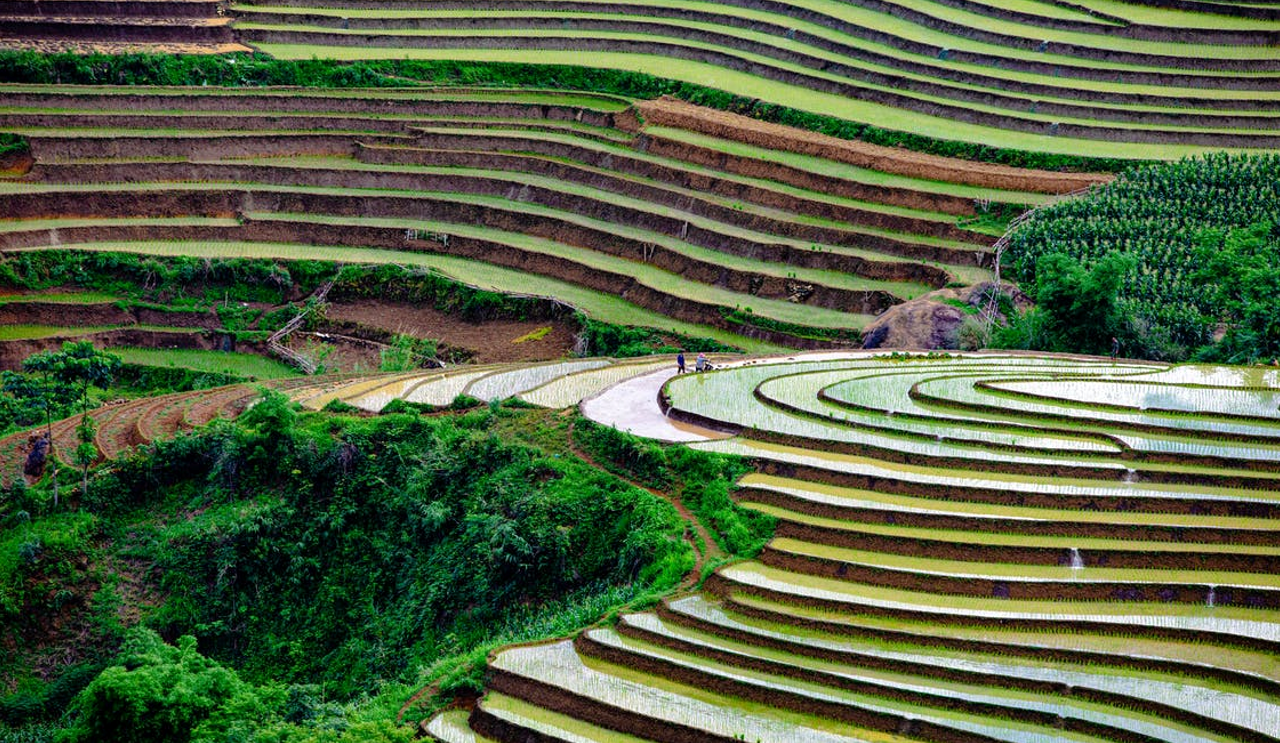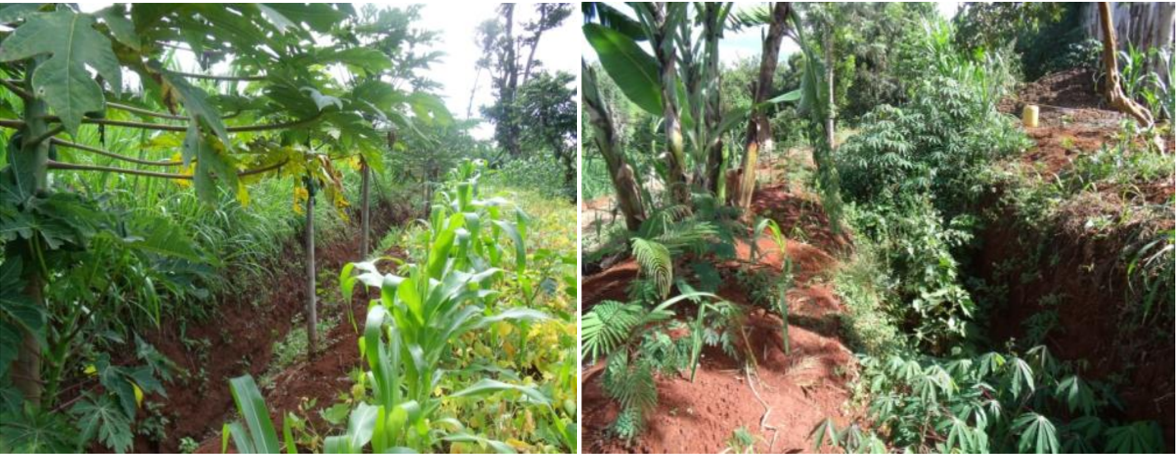Soil and water conserving irrigation methods and alternatives

This post is also available in:
This post is also available in:
![]() Français (French)
Français (French) ![]() Deutsch (German)
Deutsch (German) ![]() हिन्दी (Hindi)
हिन्दी (Hindi) ![]() العربية (Arabic)
العربية (Arabic) ![]() 简体中文 (Chinese (Simplified))
简体中文 (Chinese (Simplified)) ![]() Português (Portuguese (Brazil))
Português (Portuguese (Brazil)) ![]() polski (Polish)
polski (Polish)
Cover Photo: Irrigation by water conservation for rice growing. Soil and water conservation can be combined with irrigation e.g. flood irrigation of rice in Vietnam (above). Water can also be conserved by promoting infiltration into the soil, storage in tanks or dams, or using irrigation water more efficiently.
Water Conservation
Water can be conserved by fighting the wind and water erosion, as mentioned, but also by improving Water Use Efficiency, e.g., with suitable nutrient supply and irrigation of the crop.
- In brief, several essential strategies have been covered to improve the water balance in the fields. These include reducing wind speeds to limit evapotranspiration of water and promote water infiltration in the soil, organic matter content, soil structure, and root growth deeper into the ground. Also, intercropping and agroforestry can sometimes reduce farmers’ economic risk regarding drought problems, and be combined with water and soil conserving soil structures. Figure 1 below.
- Water Use Efficiency is crop yield per unit of water used. It can be improved by reducing other problems like soil fertility or integrated pest management or by irrigating more effectively.
- Limiting growth factors. Water availability and soil fertility are the most common challenges for crops. Investing in one without the other may not be effective, at least in problem years. Like fertilization, irrigation may help if applied well and can harm if done wrong. Crop nutrition is not only about removing another constraint to crop growth but also affecting drought resilience.
- Improved crop nutrition can sometimes also directly conserve water. Potassium (element K) deficiency weakens green parts’ ability to close pores (stomata) and stop transpiration when needed. K deficiency often gives yellow or wilting margins to mature leaves before the leaves are old. Phosphate (P) deficiency delays the growth of all parts and maturity. Severe lack of nutrients generally causes small tops only produce sugar to a small and shallow root system, e.g., on some small tropical farms.
- However, a very high level of nutrients combined with enough water in the topsoil can make root systems shorter and more superficial. This is because the well-supplied tops can use almost all their sugars for new growth leaving little to the roots. This is also documented in the case of phosphate despite conflicting generalizations in the literature.
- Irrigation amounts can be more effective by watering when needed. There are mathematical formulas that can be used to calculate this. Else, soil moisture can be observed at relevant depth (colour and feel), and sensitive drought indicator plants may show drought stress clearly before the crop stops growing and later show it. Calculations can be based on daily temperature, wind, crops, soil and irrigation efficiency, and rain, e.g., using FAO (www.fao.org/3/S2022E/s2022e08.htm) or suitable apps. Rainfall events below 2 mm can be discarded as ineffective for plant growth. Also, leaf temperature increases when the plant stops transpiration by closing the lip cells (stomata). A drone, balloon, or kite with an IR camera may help.
- Sensitive crop stages. Irrigation can be focused on drought-sensitive stages of the crops like germination, pollination and grain/fruit filling, For young wet rice (=paddy rice), weed control by flooding, and only a few times is enough. This can save much water compared to constant flooding. This can be combined with seeding or planting rice in rows and recent types of simple weeding tools. Google e.g.: System of Rice Intensification (SRI). However, irrigation in hot sunny weather may also lead the heat from the surface down to the seed, while dry soil is more insulating. Irrigation in hot weather can, in any case, be less effective.
- Irrigation efficiency can be improved using sprinkler irrigation compared to flood irrigation (in most fields). The suitable slope and permeability of the soil are important for flood irrigation. Drip and similar trickle irrigation are most effective but require relatively high investments. However, the farmer can use moveable hoses. The water may get hot in above-ground pipes, but openings clogging underground pipes can be even more challenging. Small-scale systems can be assembled near a raised container with filters. Photos and introduction can be seen here: trickle irrigation.
- Frequent superficial irrigation is mainly needed when establishing plants, e.g., using small seeds or plantlets. Supply of large amounts of water, and big fast drops, can damage soil structure. However, less frequent irrigation gives less evaporation from the soil surface. Deeper wetting of the soil can promote deeper root development. The root system can take up water and mobile nutrients like nitrate-nitrogen (NO3-) and potassium (K+) that may have been washed (leached)in deep soil layers due to intensive rainfalls on bare ground. Shallow roots can also help to take up nutrients in the topsoil. Furthermore, long (not deep) root systems with common symbiotic fungi and moisture are particularly important to take up phosphate. Young plants need the highest availability. If much water needs to be applied simultaneously, then erosion, run-off, compaction, and surface sealing of pores can be a problem. Thus, watered pots need sandy or fibrous potting mixtures. Water may leak slowly from a proper hose, bag, or other container or be poured into a hole where the surface soil may seal and release the water slowly. Sand holds little water, and it moves fast. Clay retains much water leaving little for the plants to absorb, and the soil’s wilting point will be reached first. The medium texture, silt, holds most plant-available water but is erodible and gives unstable soil structure. Mixed textures and organic matter improve soil’s ability to hold plant-available water and reduce soil structure problems. Artificial substances can also increase water-holding capacity, but a common type, polyacrylic amid, is suspected of causing cancer risk.
- Deep root growth can reduce irrigation needs by giving access to water and making deep root growth of the following crops possible. Some plants can open compact soils, e.g., pigeon pea (Cajanus cajan) in semi-arid tropics and, e.g., yellow lupin or fodder radish in temperate. Big and deep pores after some dead roots can lead water down fast. It can help against erosion, but sometimes water can move too deep too quickly with nutrients, even phosphate, and pesticides. Well-developed roots of perennial grasses and rye can be considered, but taproots tend to penetrate best. Roots may be stopped by hardpans (layers) of reddish iron oxides, compact clay, and acid soil – with pH in water (soil: water 1: 2.5) less than 5.5 for sensitive plants and 5.0 for others. In such acid soils high in exchangeable (acid-soluble) aluminium, roots cannot extend well and get stunted on sensitive plants. Liming tropical soils above pH 5.5 in water often cause micronutrient deficiencies affecting young leaves’ colour, shape, or fruits. The pH extracted in diluted CaCl2 or KCl will be about 0.5 and 1.0 units lower, respectively. See also the planned Chapter on integrated soil fertility management.
- Drainage is often neglected when irrigating. Excess water should be able to be drained off. In arid and semi-arid areas, the rain will usually be too low to wash salts from irrigation water out of the soil. Salts will accumulate without care and cause plant toxicities (e.g., sodium, chloride, and bicarbonate are toxic to sensitive plants). Thus, excess irrigation with drainage is sometimes needed. Care is particularly needed if we can taste the salts in the irrigation water. Electric Conductivity (EC) indicates the total salt concentration, but the analytical method (concentration and units) matters, and the plant’s tolerance differs much. Sodium (Na+) is also a problem for soil structure, mainly if the amount of calcium and magnesium is low. Soil can also become very alkaline, and organic matter disperses, giving black alkali soils. Salt-affected white alkali soils occur too. The use of gypsum (CaSO4) and/or salt bushes (Atriplex spp.) can help. Irrigation, at least in semi-arid and arid areas, requires more insight or experience than can be covered here.
- Mulch cover can sometimes reduce water loss from surfaces.
Mulch is a surface cover of dead plant litter or other materials. The soil surface under the mulch will often appear cooler and moister. However, light rain may also stay on top of the mulch away from the roots, and mulch can harbour insects cutting seedlings and attract scraping hens or snakes. Fire may spread in mulch, or nitrogen can get lost in the air as ammonia from N-rich mulch. A visibly dry soil surface will only dry out slowly if it is without active plants or big soil clods. This is caused by suction (capillary water movement) broken by surface drought.
- Greenhouses sometimes recycle much of the water used. Still, enough ventilation is needed to keep the CO2 levels up during the daytime. In the UK, CO2 from power stations is recycled to huge greenhouses nearby, but it requires clean and controlled exhaust gasses monitored, e.g., toxic carbon monoxide (CO).
- Drought-tolerant plants can help. A drought tolerant plant can have one or more of the following abilities-characteristics:
- can rapidly grow tops and roots when rains are reliable,
- the shoots and roots can survive dry periods (different genes),
- reproduce (e.g. produce fruits or grains) and mature early, when there is still plenty of soil moisture, and “escape” the drought,
- have wax layers/hairs and leaves rolling together.
- Conserving fruits and vegetables rather than growing them irrigated in the dry season. To avoid the browning of drying fruits, controlled heating to about 60-80°C for about 5-10 minutes can often be used to spoil some of the phenolase enzymes causing browning by oxidation. Antioxidants, e.g., lemon juice, can help too for a while (Zawawi et al. 2022). Agroforestry can also provide wood for good drying and storage structures.
- A low-cost establishment method like improved direct seeding can help plants tolerate water shortage by promoting early root growth. It can help avoid the sensitive stage where damaged roots shall supply tops with water or by making it affordable to re-establish in case of failure. What appears as a drought problem during germination in the hot sun can be due to soil surface heat. In some cases, raising seedlings, e.g., from an irrigated greenhouse or screen house, may save irrigation water if done right.
- Integrated approach, More irrigation is not the only solution to water shortage or farming, as many claims. However, if it is applied well, it can often help much. However, if it is applied in the wrong way, it can be devastating. To summarize, much water can be conserved by an integrated, holistic approach to crops’ water supply (and livestock getting shade and being fed good feed). However, many details are important and often neglected. More details on some aspects can be found in other sections.

Figure 1. Conserving water at site (“in situ”). Water conservation can include water infiltration or retention ditches (if landslides are not a problem). P Most soil and water conservation methods can help by reducing wind and/or increasing water infiltration through the soil surface and soil organic matter. Water conservation can also include effective irrigation methods — and solving other problems for plants so they can use the available water effectively. From Muriuki & Macharia (2011).
References
Baumhardt RL, and Blanco-Canqui H 2014 Soil: Conservation Practices. In: Neal Van Alfen, editor-in-chief. Encyclopedia of Agriculture and Food Systems 5, Elsevier, 153-165.
Falkenmark M 1995, Water Linkages. ISRIC. https://www.isric.org/documents/document-type/green-water-credits-report-k12-inventory-and-analysis-existing-soil-and Open access.
Hudson W N 1987 Soil and water conservation in semi-arid areas. Silsoe Associates Ampthill, Bedford United Kingdom. Soil Resources, Management and Conservation Service. FAO Land and Water Development Division. Food and Agriculture Organization of the United Nations Rome, 1987 https://www.fao.org/3/t0321e/t0321e00.htm
Land and Water Division 2000 Manual on Integrated Soil Management and Conservation Practices. FAO land and water bulletin Series number: 1024-6703. 214 pp. ISBN: 9251044171 https://www.fao.org/publications/card/en/c/31f117c4-13e2-5631-bf16-ebaaa10b714f
Muriuki JP, Macharia PN 2011 Green Water Credits Report K12: Inventory and Analysis of Existing Soil and Water Conservation Practices in Upper Tana, Kenya. https://www.isric.org/documents/document-type/green-water-credits-report-k12-inventory-and-analysis-existing-soil-and Open access.
Mandal T. 2010. Low-cost soil and water conservation with many early benefits. Presentation Researchers’ Day: Climate Change Impact, Adaptation and Mitigation GEUS, Inst. of Geography, University of Copenhagen. 7 October 2010. Arranged by the Climate Change Task Force. https://www.yumpu.com/en/document/view/35209735/present-danish-water-forum
Plant and Soil Sciences eLibrary 2022. Irrigation Chapter 8 and 9. Dept. of Agronomy and Horticulture, University of Nebraska. https://passel2.unl.edu/view/lesson/bda727eb8a5a/8
Thomas DB et al. 1997. Soil and water conservation manual. Soil and Water Conservation Branch, Min. Agric. Livestock Dev. and Marketing, Nairobi Kenya.
Watene G and others 2021 Water Erosion Risk Assessment in the Kenya Great Rift Valley Region Sustainability 2021, 13(2), 844; https://doi.org/10.3390/su13020844
Zawawi N A F et al. 2022 How Thermal, High Pressure, and Ultrasound Inactivation of Various Fruit Cultivars’ Polyphenol Oxidase: Kinetic Inactivation Models and Estimation of Treatment Energy Requirement. Appl. Sci. 2022, 12, 1864; https://doi.org/10.3390/app12041864









































































